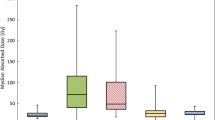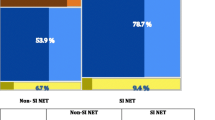Abstract
Purpose
Bulky disease is an adverse prognostic factor for 177Lu-DOTA-octreotate (177Lu-DOTATATE) peptide receptor radionuclide therapy (PRRT). 90Y-DOTA-octreotate (90Y-DOTATATE) has theoretical advantages in this setting but may less effectively treat co-existent smaller deposits and have higher toxicity than 177Lu-DOTATATE. The aim of this study was to assess the efficacy and safety of using these agents sequentially.
Methods
We reviewed patients (pts) with at least one lesion of a transaxial diameter >4 cm who completed 1–2 cycles of 90Y-DOTATATE followed by 2–3 cycles of 177Lu-DOTATATE, with treatment empirically adapted to disease size and burden in individual patients. Data collected included morphological and molecular imaging response, toxicity, and progression-free and overall survival.
Results
Twenty-six pts (17 men; aged 27–74 years) received a median cumulative activity of 6.5 GBq 90Y-DOTATATE, and 21 GBq 177Lu-DOTATATE. All but one received radiosensitising chemotherapy. Adverse prognostic factors included ENETS grade 2 or 3 in 58 %, and FDG-avid disease in 73 %. Nineteen pts treated for progressive disease had stabilisation (37 %) or regression on CT (42 % partial response, 21 % minor response), with a mean 59 % (8–99 %) reduction in disease burden. All seven pts treated for uncontrolled symptoms reported improvement during PRRT with 4/7 having complete symptom resolution at 3 months. Eight patients had grade 3/4 lymphopaenia, and two patients grade 3/4 thrombocytopaenia without significant hepatic or renal toxicity. Median survival was not reached after a median follow-up of 35 months. Median progression-free survival was 33 months.
Conclusion
PRCRT with 90Y -DOTATATE followed by 177Lu-DOTATATE in individualised regimens achieved high clinical and morphological response in patients with bulky tumours. Despite lack of a control arm, the efficacy of this treatment approach appears higher than reported results with either agent used alone or other approved treatments, particularly given the adverse prognostic features of this cohort.






Similar content being viewed by others
References
Yao JC, Hassan M, Phan A, Dagohoy C, Leary C, Mares JE, et al. One hundred years after “carcinoid”: epidemiology of and prognostic factors for neuroendocrine tumors in 35,825 cases in the United States. J Clin Oncol Off J Am Soc Clin Oncol. 2008;26(18):3063–72. doi:10.1200/JCO.2007.15.4377.
Scarpa A, Mantovani W, Capelli P, Beghelli S, Boninsegna L, Bettini R, et al. Pancreatic endocrine tumors: improved TNM staging and histopathological grading permit a clinically efficient prognostic stratification of patients. Mod Pathol Off J US Can Acad Pathol Inc. 2010;23(6):824–33. doi:10.1038/modpathol.2010.58.
Pavel M, Baudin E, Couvelard A, Krenning E, Oberg K, Steinmuller T, et al. ENETS consensus guidelines for the management of patients with liver and other distant metastases from neuroendocrine neoplasms of foregut, midgut, hindgut, and unknown primary. Neuroendocrinology. 2012;95(2):157–76. doi:10.1159/000335597.
Kwekkeboom DJ, de Herder WW, Kam BL, van Eijck CH, van Essen M, Kooij PP, et al. Treatment with the radiolabeled somatostatin analog [177 Lu-DOTA 0,Tyr3]octreotate: toxicity, efficacy, and survival. J Clin Oncol Off J Am Soc Clin Oncol. 2008;26(13):2124–30. doi:10.1200/JCO.2007.15.2553.
Teunissen JJ, Kwekkeboom DJ, Valkema R, Krenning EP. Nuclear medicine techniques for the imaging and treatment of neuroendocrine tumours. Endocr Relat Cancer. 2011;18 Suppl 1:S27–51. doi:10.1530/ERC-10-0282.
Pavel M, Kidd M, Modlin I. Systemic therapeutic options for carcinoid. Semin Oncol. 2013;40(1):84–99. doi:10.1053/j.seminoncol.2012.11.003.
Toumpanakis C, Caplin ME. Update on the role of somatostatin analogs for the treatment of patients with gastroenteropancreatic neuroendocrine tumors. Semin Oncol. 2013;40(1):56–68. doi:10.1053/j.seminoncol.2012.11.006.
Kong G, Thompson M, Collins M, Herschtal A, Hofman MS, Johnston V, et al. Assessment of predictors of response and long-term survival of patients with neuroendocrine tumour treated with peptide receptor chemoradionuclide therapy (PRCRT). Eur J Nucl Med Mol Imaging. 2014;41(10):1831–44. doi:10.1007/s00259-014-2788-5.
Ruszniewski P. 177Lu-DOTATATE significantly improves progression-free survival in patients with mid-gut neuroendocrine tumours: results of the phase III NETTER-1 trial [abstract LBA 6]. 2015.
Bodei L, Mueller-Brand J, Baum RP, Pavel ME, Horsch D, O’Dorisio MS, et al. The joint IAEA, EANM, and SNMMI practical guidance on peptide receptor radionuclide therapy (PRRNT) in neuroendocrine tumours. Eur J Nucl Med Mol Imaging. 2013;40(5):800–16. doi:10.1007/s00259-012-2330-6.
Bodei L, Cremonesi M, Grana CM, Chinol M, Baio SM, Severi S, et al. Yttrium-labelled peptides for therapy of NET. Eur J Nucl Med Mol Imaging. 2012;39 Suppl 1:S93–102. doi:10.1007/s00259-011-2002-y.
Otte A, Herrmann R, Heppeler A, Behe M, Jermann E, Powell P, et al. Yttrium-90 DOTATOC: first clinical results. Eur J Nucl Med. 1999;26(11):1439–47.
Imhof A, Brunner P, Marincek N, Briel M, Schindler C, Rasch H, et al. Response, survival, and long-term toxicity after therapy with the radiolabeled somatostatin analogue [90Y-DOTA]-TOC in metastasized neuroendocrine cancers. J Clin Oncol Off J Am Soc Clin Oncol. 2011;29(17):2416–23. doi:10.1200/JCO.2010.33.7873.
Nisa L, Savelli G, Giubbini R. Yttrium-90 DOTATOC therapy in GEP-NET and other SST2 expressing tumors: a selected review. Ann Nucl Med. 2011;25(2):75–85. doi:10.1007/s12149-010-0444-0.
Bodei L, Cremonesi M, Grana CM, Fazio N, Iodice S, Baio SM, et al. Peptide receptor radionuclide therapy with (1)(7)(7)Lu-DOTATATE: the IEO phase I-II study. Eur J Nucl Med Mol Imaging. 2011;38(12):2125–35. doi:10.1007/s00259-011-1902-1.
Kashyap R, Jackson P, Hofman MS, Eu P, Beauregard JM, Zannino D, et al. Rapid blood clearance and lack of long-term renal toxicity of 177Lu-DOTATATE enables shortening of renoprotective amino acid infusion. Eur J Nucl Med Mol Imaging. 2013;40(12):1853–60. doi:10.1007/s00259-013-2504-x.
Kong G, Johnston V, Ramdave S, Lau E, Rischin D, Hicks RJ. High-administered activity In-111 octreotide therapy with concomitant radiosensitizing 5FU chemotherapy for treatment of neuroendocrine tumors: preliminary experience. Cancer Biother Radiopharm. 2009;24(5):527–33. doi:10.1089/cbr.2009.0644.
Hubble D, Kong G, Michael M, Johnson V, Ramdave S, Hicks RJ. 177Lu-octreotate, alone or with radiosensitising chemotherapy, is safe in neuroendocrine tumour patients previously treated with high-activity 111In-octreotide. Eur J Nucl Med Mol Imaging. 2010;37(10):1869–75. doi:10.1007/s00259-010-1483-4.
Fine RL, Gulati AP, Krantz BA, Moss RA, Schreibman S, Tsushima DA, et al. Capecitabine and temozolomide (CAPTEM) for metastatic, well-differentiated neuroendocrine cancers: the Pancreas Center at Columbia University experience. Cancer Chemother Pharmacol. 2013;71(3):663–70. doi:10.1007/s00280-012-2055-z.
Strosberg JR, Fine RL, Choi J, Nasir A, Coppola D, Chen DT, et al. First-line chemotherapy with capecitabine and temozolomide in patients with metastatic pancreatic endocrine carcinomas. Cancer. 2011;117(2):268–75. doi:10.1002/cncr.25425.
Claringbold PG, Price RA, Turner JH. Phase I-II study of radiopeptide 177Lu-octreotate in combination with capecitabine and temozolomide in advanced low-grade neuroendocrine tumors. Cancer Biother Radiopharm. 2012;27(9):561–9. doi:10.1089/cbr.2012.1276.
Wahl RL, Jacene H, Kasamon Y, Lodge MA. From RECIST to PERCIST: evolving considerations for PET response criteria in solid tumors. J Nucl Med. 2009;50(1):122S–50. doi:10.2967/jnumed.108.057307.
Hicks RJ. The role of PET in monitoring therapy. Cancer Imaging Off Publ Int Cancer Imaging Soc. 2005;5:51–7. doi:10.1102/1470-7330.2005.0006.
Eisenhauer EA, Therasse P, Bogaerts J, Schwartz LH, Sargent D, Ford R, et al. New response evaluation criteria in solid tumours: revised RECIST guideline (version 1.1). Eur J Cancer. 2009;45(2):228–47. doi:10.1016/j.ejca.2008.10.026.
Vinjamuri S, Gilbert TM, Banks M, McKane G, Maltby P, Poston G, et al. Peptide receptor radionuclide therapy with (90)Y-DOTATATE/(90)Y-DOTATOC in patients with progressive metastatic neuroendocrine tumours: assessment of response, survival and toxicity. Br J Cancer. 2013;108(7):1440–8. doi:10.1038/bjc.2013.103.
Sowa-Staszczak A, Pach D, Kunikowska J, Krolicki L, Stefanska A, Tomaszuk M, et al. Efficacy and safety of 90Y-DOTATATE therapy in neuroendocrine tumours. Endokrynol Pol. 2011;62(5):392–400.
Bushnell Jr DL, O’Dorisio TM, O’Dorisio MS, Menda Y, Hicks RJ, Van Cutsem E, et al. 90Y-edotreotide for metastatic carcinoid refractory to octreotide. J Clin Oncol Off J Am Soc Clin Oncol. 2010;28(10):1652–9. doi:10.1200/JCO.2009.22.8585.
Cwikla JB, Sankowski A, Seklecka N, Buscombe JR, Nasierowska-Guttmejer A, Jeziorski KG, et al. Efficacy of radionuclide treatment DOTATATE Y-90 in patients with progressive metastatic gastroenteropancreatic neuroendocrine carcinomas (GEP-NETs): a phase II study. Ann Oncol Off J Eur Soc Med Oncol ESMO. 2010;21(4):787–94. doi:10.1093/annonc/mdp372.
van Essen M, Sundin A, Krenning EP, Kwekkeboom DJ. Neuroendocrine tumours: the role of imaging for diagnosis and therapy. Nat Rev Endocrinol. 2014;10(2):102–14. doi:10.1038/nrendo.2013.246.
Binderup T, Knigge U, Loft A, Federspiel B, Kjaer A. 18F-fluorodeoxyglucose positron emission tomography predicts survival of patients with neuroendocrine tumors. Clin Cancer Res Off J Am Assoc Cancer Res. 2010;16(3):978–85. doi:10.1158/1078-0432.CCR-09-1759.
Kashyap R, Hofman MS, Michael M, Kong G, Akhurst T, Eu P, et al. Favourable outcomes of (177)Lu-octreotate peptide receptor chemoradionuclide therapy in patients with FDG-avid neuroendocrine tumours. Eur J Nucl Med Mol Imaging. 2015;42(2):176–85. doi:10.1007/s00259-014-2906-4.
Hofman MS, Michael M, Kashyap R, Hicks RJ. Modifying the poor prognosis associated with 18F-FDG-Avid NET with peptide receptor chemo-radionuclide therapy (PRCRT). J Nucl Med. 2015;56(6):968–9. doi:10.2967/jnumed.115.154500.
Barber TW, Hofman MS, Thomson BN, Hicks RJ. The potential for induction peptide receptor chemoradionuclide therapy to render inoperable pancreatic and duodenal neuroendocrine tumours resectable. Eur J Surg Oncol J Eur Soc Surg Oncol Br Assoc Surg Oncol. 2012;38(1):64–71. doi:10.1016/j.ejso.2011.08.129.
van Vliet EI, van Eijck CH, de Krijger RR, Nieveen van Dijkum EJ, Teunissen JJ, Kam BL, et al. Neoadjuvant treatment of nonfunctioning pancreatic neuroendocrine tumors with [177Lu-DOTA0,Tyr3]octreotate. J Nucl Med. 2015;56(11):1647–53. doi:10.2967/jnumed.115.158899.
Raymond E, Dahan L, Raoul JL, Bang YJ, Borbath I, Lombard-Bohas C, et al. Sunitinib malate for the treatment of pancreatic neuroendocrine tumors. N Engl J Med. 2011;364(6):501–13. doi:10.1056/NEJMoa1003825.
Yao JC, Shah MH, Ito T, Bohas CL, Wolin EM, Van Cutsem E, et al. Everolimus for advanced pancreatic neuroendocrine tumors. N Engl J Med. 2011;364(6):514–23. doi:10.1056/NEJMoa1009290.
Seregni E, Maccauro M, Coliva A, Castellani MR, Bajetta E, Aliberti G, et al. Treatment with tandem [(90)Y]DOTA-TATE and [(177)Lu] DOTA-TATE of neuroendocrine tumors refractory to conventional therapy: preliminary results. Q J Nucl Med Mol Imaging Off Publ Ital Assoc Nucl Med. 2010;54(1):84–91.
Villard L, Romer A, Marincek N, Brunner P, Koller MT, Schindler C, et al. Cohort study of somatostatin-based radiopeptide therapy with [(90)Y-DOTA]-TOC versus [(90)Y-DOTA]-TOC plus [(177)Lu-DOTA]-TOC in neuroendocrine cancers. J Clin Oncol Off J Am Soc Clin Oncol. 2012;30(10):1100–6. doi:10.1200/JCO.2011.37.2151.
Beauregard JM, Hofman MS, Kong G, Hicks RJ. The tumour sink effect on the biodistribution of 68Ga-DOTA-octreotate: implications for peptide receptor radionuclide therapy. Eur J Nucl Med Mol Imaging. 2012;39(1):50–6. doi:10.1007/s00259-011-1937-3.
Hofman MS, Hicks RJ. Peptide receptor radionuclide therapy for neuroendocrine tumours: standardized and randomized, or personalized? Eur J Nucl Med Mol Imaging. 2014;41(2):211–3. doi:10.1007/s00259-013-2621-6.
Acknowledgments
Professor Hicks is supported by a National Health and Medical Research Council of Australia practitioner fellowship and program grant. The authors would like to thank our excellent team of nuclear medicine technologists and radionuclide therapy nurses for their care of our patients.
Author information
Authors and Affiliations
Corresponding authors
Ethics declarations
All authors declare no conflicts of interest. All procedures performed were in accordance with the ethical standards of the institutional research committee and all patients provided informed consent for treatment.
Rights and permissions
About this article
Cite this article
Kong, G., Callahan, J., Hofman, M.S. et al. High clinical and morphologic response using 90Y-DOTA-octreotate sequenced with 177Lu-DOTA-octreotate induction peptide receptor chemoradionuclide therapy (PRCRT) for bulky neuroendocrine tumours. Eur J Nucl Med Mol Imaging 44, 476–489 (2017). https://doi.org/10.1007/s00259-016-3527-x
Received:
Accepted:
Published:
Issue Date:
DOI: https://doi.org/10.1007/s00259-016-3527-x




